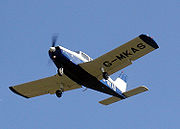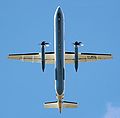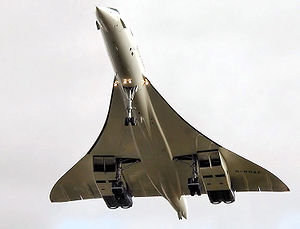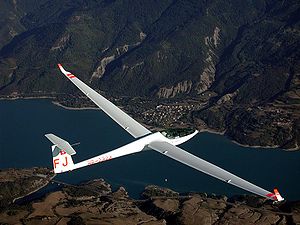.gif)
Aspect ratio (wing)
Encyclopedia
In aerodynamics
, the aspect ratio of a wing is essentially the ratio
of its length to its breadth (chord
). A high aspect ratio indicates long, narrow wings, whereas a low aspect ratio indicates short, stubby wings.
For most wings the length of the chord is not a constant but varies along the wing, so the aspect ratio is defined as the square of the wingspan
is defined as the square of the wingspan
 divided by the area
divided by the area  of the wing planform
of the wing planform
—this is equal to the length-to-breadth ratio for constant breadth.



 Aspect ratio and planform
Aspect ratio and planform
can be used to predict the aerodynamic performance of a wing.
For a given wing area, the aspect ratio is proportional to the square of the wingspan, and the wingspan
is of particular significance in determining the performance. An airplane in flight can be imagined to affect a circular cylinder of air. The diameter of that cylinder is equal to the wingspan. A large wingspan is working on a large cylinder of air, and a small wingspan is working on a small cylinder of air. For two aircraft of the same weight but different wingspans the small cylinder of air must be pushed downward by a greater amount than the large cylinder in order to produce an equal upward force. The aft-leaning component of this change in velocity is proportional to the induced drag. Therefore the larger downward velocity produces a larger aft-leaning component and this leads to larger induced drag on the aircraft with the smaller wingspan and lower aspect ratio.
The interaction between undisturbed air outside the circular cylinder of air, and the downward-moving cylinder of air occurs at the wingtips, and can be seen as wingtip vortices
.
This property of aspect ratio AR is illustrated in the formula used to calculate the drag coefficient of an aircraft

where
There are several reasons why not all aircraft have high aspect wings:
causes a decrease in aspect ratio because extending the flaps increases the wing chord
but with no change in wingspan. This decrease in aspect ratio causes an increase in induced drag which is detrimental to the airplane’s performance during takeoff but may be beneficial during landing.
Aircraft which approach or exceed the speed of sound sometimes incorporate variable-sweep wings. This is due to the difference in fluid behavior in the subsonic and transonic/supersonic regimes. In subsonic flow, induced drag is a significant component of total drag, particularly at high angle of attack
. However, as the flow becomes transonic and then supersonic, the shock wave
first generated along the wing's upper surface causes wave drag
on the aircraft, and this drag is proportional to the length of the wing - the longer the wing, the longer the shock wave. Thus a long wing, valuable at low speeds, becomes a detriment at transonic speeds. If the aircraft design can fulfil its mission profiles with the extra weight and complexity of a moveable wing, the swing-wing provides a solution to this problem.
es and eagle
s. By contrast, hawks of the genus Accipiter
such as the Eurasian Sparrowhawk have wings of low aspect ratio (and long tails) for maneuverability.
Aerodynamics
Aerodynamics is a branch of dynamics concerned with studying the motion of air, particularly when it interacts with a moving object. Aerodynamics is a subfield of fluid dynamics and gas dynamics, with much theory shared between them. Aerodynamics is often used synonymously with gas dynamics, with...
, the aspect ratio of a wing is essentially the ratio
Ratio
In mathematics, a ratio is a relationship between two numbers of the same kind , usually expressed as "a to b" or a:b, sometimes expressed arithmetically as a dimensionless quotient of the two which explicitly indicates how many times the first number contains the second In mathematics, a ratio is...
of its length to its breadth (chord
Chord (aircraft)
In aeronautics, chord refers to the imaginary straight line joining the trailing edge and the center of curvature of the leading edge of the cross-section of an airfoil...
). A high aspect ratio indicates long, narrow wings, whereas a low aspect ratio indicates short, stubby wings.
For most wings the length of the chord is not a constant but varies along the wing, so the aspect ratio
 is defined as the square of the wingspan
is defined as the square of the wingspanWingspan
The wingspan of an airplane or a bird, is the distance from one wingtip to the other wingtip. For example, the Boeing 777 has a wingspan of about ; and a Wandering Albatross caught in 1965 had a wingspan of , the official record for a living bird.The term wingspan, more technically extent, is...
 divided by the area
divided by the area  of the wing planform
of the wing planformPlanform
In aviation, a planform is the shape and layout of a fixed-wing aircraft's fuselage and wing. Of all the myriad planforms used, they can typically be grouped into those used for low-speed flight, found on general aviation aircraft, and those used for high-speed flight, found on many military...
—this is equal to the length-to-breadth ratio for constant breadth.

Aspect ratio of aircraft wings




Planform
In aviation, a planform is the shape and layout of a fixed-wing aircraft's fuselage and wing. Of all the myriad planforms used, they can typically be grouped into those used for low-speed flight, found on general aviation aircraft, and those used for high-speed flight, found on many military...
can be used to predict the aerodynamic performance of a wing.
For a given wing area, the aspect ratio is proportional to the square of the wingspan, and the wingspan
Wingspan
The wingspan of an airplane or a bird, is the distance from one wingtip to the other wingtip. For example, the Boeing 777 has a wingspan of about ; and a Wandering Albatross caught in 1965 had a wingspan of , the official record for a living bird.The term wingspan, more technically extent, is...
is of particular significance in determining the performance. An airplane in flight can be imagined to affect a circular cylinder of air. The diameter of that cylinder is equal to the wingspan. A large wingspan is working on a large cylinder of air, and a small wingspan is working on a small cylinder of air. For two aircraft of the same weight but different wingspans the small cylinder of air must be pushed downward by a greater amount than the large cylinder in order to produce an equal upward force. The aft-leaning component of this change in velocity is proportional to the induced drag. Therefore the larger downward velocity produces a larger aft-leaning component and this leads to larger induced drag on the aircraft with the smaller wingspan and lower aspect ratio.
The interaction between undisturbed air outside the circular cylinder of air, and the downward-moving cylinder of air occurs at the wingtips, and can be seen as wingtip vortices
Wingtip vortices
Wingtip vortices are tubes of circulating air that are left behind a wing as it generates lift. One wingtip vortex trails from the tip of each wing. The cores of vortices spin at very high speed and are regions of very low pressure...
.
This property of aspect ratio AR is illustrated in the formula used to calculate the drag coefficient of an aircraft


where
 |
is the aircraft drag coefficient Drag coefficient In fluid dynamics, the drag coefficient is a dimensionless quantity that is used to quantify the drag or resistance of an object in a fluid environment such as air or water. It is used in the drag equation, where a lower drag coefficient indicates the object will have less aerodynamic or... |
 |
is the aircraft zero-lift drag coefficient, |
 |
is the aircraft lift coefficient, |
 |
is the circumference-to-diameter ratio of a circle, |
 |
is the Oswald efficiency number Oswald efficiency number The Oswald efficiency, similar to the span efficiency, is a correction factor that represents the change in drag with lift of a three dimensional wing or airplane, as compared with an ideal wing having the same aspect ratio and an elliptical lift distribution.-Definition:The Oswald efficiency is... |
 |
is the aspect ratio. |
There are several reasons why not all aircraft have high aspect wings:
- Structural: A long wing has higher bending stress for a given load than a short one, which requires stronger structure to withstand. Also, longer wings have greater deflection for a given load, and in some applications this deflection is undesirable (e.g. if the deflected wing interferes with aileronAileronAilerons are hinged flight control surfaces attached to the trailing edge of the wing of a fixed-wing aircraft. The ailerons are used to control the aircraft in roll, which results in a change in heading due to the tilting of the lift vector...
movement).
- Maneuverability: a high aspect-ratio wing will have a lower roll rateRoll rateRoll rate may refer to:* Roll Rate Analysis: involves comparing worst delinquency in a specified “previous x ” months with that in the “next x” months, and then calculating the percentage of accounts that maintain their worst delinquency, get better, or “roll forward” into the next delinquency...
than one of low aspect ratio, because in a high-aspect-ratio wing, an equal amount of wing movement due to aileron deflection (at the aileron) will result in less rolling action on the fuselage due to the greater length between the aileron and the fuselage. A higher aspect ratio wing will also have a higher moment of inertia to overcome. Due to the lower roll rates, high aspect ratio wings are usually not used on fighter aircraftFighter aircraftA fighter aircraft is a military aircraft designed primarily for air-to-air combat with other aircraft, as opposed to a bomber, which is designed primarily to attack ground targets...
.
- Parasitic drag: While high aspect wings create less induced drag, they have greater parasitic dragParasitic dragParasitic drag is drag caused by moving a solid object through a fluid medium . Parasitic drag is made up of many components, the most prominent being form drag...
, (drag due to shape, frontal area, and surface friction). This is because, for an equal wing area, the average chord (length in the direction of wind travel over the wing) is smaller. Due to the effects of Reynolds Number, the value of the section drag coefficient is an inverse logarithmic function of the characteristic length of the surface, which means that, even if two wings of the same area are flying at equal speeds and equal angles of attack, the section drag coefficient is slightly higher on the wing with the smaller chord. However, this variation is very small when compared to the variation in induced drag with changing wingspan.
For example, the section drag coefficient of a NACANACA- Organizations :* National Advisory Committee for Aeronautics, the forerunner of the U.S. federal agency NASA* National Association for Campus Activities, an organization for programmers of university and college activities...
of a NACANACA- Organizations :* National Advisory Committee for Aeronautics, the forerunner of the U.S. federal agency NASA* National Association for Campus Activities, an organization for programmers of university and college activities...
23012 airfoil (at typical lift coefficients) is inversely proportional to chord length to the power 0.129: A 20 percent increase in chord length would decrease the section drag coefficient by 2.38 percent.
A 20 percent increase in chord length would decrease the section drag coefficient by 2.38 percent.
- Practicality: low aspect ratios have a greater useful internal volume, since the maximum thickness is greater, which can be used to house the fuel tanks, retractable landing gearLanding GearLanding Gear is Devin the Dude's fifth studio album. It was released on October 7, 2008. It was his first studio album since signing with the label Razor & Tie. It features a high-profile guest appearance from Snoop Dogg. As of October 30, 2008, the album has sold 18,906 copies.-Track...
and other systems.
- Airfield Size: Airfields, hangars and other ground equipment define a maximum wingspan, which cannot be exeeded, and to generate enough lift at the given wingspan, the aircraft designer has to lower the aspect-ratio and increase the total wing area.
Variable aspect ratio
Extending the trailing-edge wing flapsFlap (aircraft)
Flaps are normally hinged surfaces mounted on the trailing edges of the wings of a fixed-wing aircraft to reduce the speed an aircraft can be safely flown at and to increase the angle of descent for landing without increasing air speed. They shorten takeoff and landing distances as well as...
causes a decrease in aspect ratio because extending the flaps increases the wing chord
Chord (aircraft)
In aeronautics, chord refers to the imaginary straight line joining the trailing edge and the center of curvature of the leading edge of the cross-section of an airfoil...
but with no change in wingspan. This decrease in aspect ratio causes an increase in induced drag which is detrimental to the airplane’s performance during takeoff but may be beneficial during landing.
Aircraft which approach or exceed the speed of sound sometimes incorporate variable-sweep wings. This is due to the difference in fluid behavior in the subsonic and transonic/supersonic regimes. In subsonic flow, induced drag is a significant component of total drag, particularly at high angle of attack
Angle of attack
Angle of attack is a term used in fluid dynamics to describe the angle between a reference line on a lifting body and the vector representing the relative motion between the lifting body and the fluid through which it is moving...
. However, as the flow becomes transonic and then supersonic, the shock wave
Shock wave
A shock wave is a type of propagating disturbance. Like an ordinary wave, it carries energy and can propagate through a medium or in some cases in the absence of a material medium, through a field such as the electromagnetic field...
first generated along the wing's upper surface causes wave drag
Wave drag
In aeronautics, wave drag is a component of the drag on aircraft, blade tips and projectiles moving at transonic and supersonic speeds, due to the presence of shock waves. Wave drag is independent of viscous effects.- Overview :...
on the aircraft, and this drag is proportional to the length of the wing - the longer the wing, the longer the shock wave. Thus a long wing, valuable at low speeds, becomes a detriment at transonic speeds. If the aircraft design can fulfil its mission profiles with the extra weight and complexity of a moveable wing, the swing-wing provides a solution to this problem.
Aspect ratio of bird wings
High aspect ratio wings abound in nature. Most birds that fly long distances have wings of high aspect ratio, and with tapered or elliptical wingtips. This is particularly noticeable on soaring birds such as albatrossAlbatross
Albatrosses, of the biological family Diomedeidae, are large seabirds allied to the procellariids, storm-petrels and diving-petrels in the order Procellariiformes . They range widely in the Southern Ocean and the North Pacific...
es and eagle
Eagle
Eagles are members of the bird family Accipitridae, and belong to several genera which are not necessarily closely related to each other. Most of the more than 60 species occur in Eurasia and Africa. Outside this area, just two species can be found in the United States and Canada, nine more in...
s. By contrast, hawks of the genus Accipiter
Accipiter
The genus Accipiter is a group of birds of prey in the family Accipitridae, many of which are named as goshawks and sparrowhawks. They can be anatomically distinguished from their relatives by the lack of a procoracoid foramen. Two small and aberrant species usually placed here do possess a large...
such as the Eurasian Sparrowhawk have wings of low aspect ratio (and long tails) for maneuverability.

